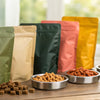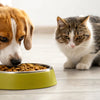What Happens If a Dog Eats Dry Cat Food?
- Houndsy
Table of Contents
- Introduction
- Understanding the Nutritional Differences
- What Happens When Dogs Eat Cat Food?
- Steps to Take If Your Dog Eats Cat Food
- Preventing Your Dog from Eating Cat Food
- Conclusion
- FAQs
Introduction
Have you ever walked into a room to find your dog contentedly munching on your cat's food? It's a scenario that many pet owners face, often leading to a mix of amusement and concern. According to a survey conducted by the American Pet Products Association, approximately 67% of U.S. households own a pet, and many of these homes host both dogs and cats. This overlap in dietary interests can create confusion and anxiety for pet parents wondering whether it’s safe for their canine companions to indulge in cat food.
When we see our dogs nibbling on cat food, it raises an important question: What happens if a dog eats dry cat food? This blog post aims to shed light on this common scenario, outlining the potential risks and nutritional differences between dog and cat food. By the end of this article, we hope to provide you with a deeper understanding of how to manage this issue effectively and keep your pets healthy and happy.
We'll cover the following aspects:
- The nutritional differences between dog food and cat food
- Common symptoms if a dog eats cat food
- Potential health risks associated with regular cat food consumption for dogs
- Steps to take if your dog eats cat food
- Tips on preventing your dog from eating cat food in the future
Let’s dive into this topic to ensure we’re all well-informed about our pets' dietary needs.
Understanding the Nutritional Differences
Before we delve into the implications of dogs eating cat food, it's essential to understand the nutritional differences between the two.
Dog Food vs. Cat Food
Dogs are omnivores, meaning they thrive on a balanced diet composed of both animal and plant-based ingredients. In contrast, cats are obligate carnivores, requiring a diet primarily made up of meat. This fundamental difference leads to significant variations in the nutritional content of their respective foods.
- Protein Content: Cat food generally contains higher levels of protein and fat compared to dog food. The Association of American Feed Control Officials (AAFCO) recommends a minimum protein content of 18% for adult dogs and 26% for adult cats. This higher protein level in cat food can be tempting for dogs, as it often has a richer aroma and flavor.
- Fat Levels: Cat food typically has a higher fat content, which can be problematic for dogs, particularly those prone to obesity or pancreatitis. While dog food has a minimum fat content requirement of 5.5%, cat food often exceeds 9%.
- Essential Nutrients: Certain nutrients, such as taurine, are crucial for cats but not required for dogs. While dogs can synthesize taurine, cats cannot, which is why it is a key ingredient in cat food. This difference means that long-term consumption of cat food could lead to nutritional imbalances in dogs.
Implications of Eating Cat Food
Given these differences, it's clear that cat food is not designed for dogs. While an occasional nibble may not cause immediate harm, regular consumption can lead to various health issues.
What Happens When Dogs Eat Cat Food?
Short-Term Effects
If your dog sneaks a small amount of cat food, the most likely outcome is a mild gastrointestinal upset. Symptoms may include:
- Vomiting: Dogs may vomit as their stomachs react to the rich ingredients in cat food.
- Diarrhea: An upset stomach can lead to loose stools or diarrhea, which can be uncomfortable for your pet.
- Lethargy: The richness of cat food may lead to temporary lethargy, particularly if your dog is not used to such a high-fat diet.
Long-Term Health Risks
While most dogs will recover from a one-time incident without lasting effects, frequent consumption of cat food can lead to more severe health problems:
- Obesity: The higher fat and calorie content can lead to weight gain, especially in less active dogs. This could set the stage for obesity-related health issues.
- Pancreatitis: Dogs that consume high-fat diets, such as cat food, are at risk of developing pancreatitis, a serious condition that can lead to hospitalization. Symptoms of pancreatitis include severe vomiting, abdominal pain, and lethargy.
- Nutritional Deficiencies: Relying on cat food can result in nutritional imbalances. For instance, dogs need certain vitamins and minerals that are present in dog food but absent in cat food.
- Gastrointestinal Issues: Over time, regular consumption of cat food can lead to chronic digestive issues, including persistent diarrhea, vomiting, and discomfort.
Monitoring Your Dog
If you discover your dog has eaten cat food, observe them closely for any signs of distress. Most dogs will recover quickly, but if symptoms persist or worsen, it is important to consult a veterinarian.
Steps to Take If Your Dog Eats Cat Food
- Stay Calm: It’s easy to panic, but remember that a small amount of cat food is usually not life-threatening.
- Monitor Symptoms: Keep an eye on your dog for any signs of gastrointestinal upset, such as vomiting or diarrhea. If symptoms last more than 24 hours, or if your dog appears lethargic or in pain, contact your veterinarian.
- Hydration is Key: Ensure your dog has access to fresh water. If they are experiencing diarrhea or vomiting, they may become dehydrated.
- Skip Their Next Meal: If your dog has eaten a significant amount of cat food, consider skipping their next meal to give their digestive system a break.
- Consult Your Vet: If you have any concerns or your dog shows severe symptoms, it’s always wise to err on the side of caution and consult your veterinarian.
Preventing Your Dog from Eating Cat Food
To avoid the issue altogether, we can take proactive measures to keep our dogs away from cat food:
1. Separate Feeding Areas
One of the simplest solutions is to create separate feeding zones for your dog and cat. This can involve:
- Feeding in Different Rooms: If possible, feed your cat in a room that your dog cannot access, or close the door while they eat.
- Elevated Feeding Stations: Cats can jump higher than most dogs, so placing the cat's food on a high shelf or cat tree can deter your dog from reaching it.
2. Use Barriers
Investing in baby gates or doors that your cat can traverse but your dog cannot can help keep the two feeding areas separate.
3. Train Your Dog
Teaching your dog commands such as "leave it" can be beneficial. This helps them understand that certain foods are off-limits.
4. Store Food Securely
Using secure storage containers for cat food can prevent your dog from getting into the food when you're not around. A container with a locking mechanism can be particularly effective.
5. Consider Using Houndsy Products
At Houndsy, we understand the importance of a seamless feeding experience for both you and your pets. Our innovative solutions not only simplify feeding routines but also provide peace of mind regarding your pets' dietary habits. Explore our flagship product, the Houndsy Kibble Dispenser, to elevate your pet feeding experience while ensuring that it remains convenient and stylish.
Conclusion
While it’s common for dogs to sneak a bite of cat food, understanding the potential risks involved is crucial for every pet owner. By recognizing the differences in nutritional needs between dogs and cats, we can better safeguard our pets’ health. Occasional consumption of cat food may lead to mild gastrointestinal upset, but regular access can result in serious health issues like obesity and pancreatitis.
Being proactive in separating feeding times, using barriers, and providing the right nutrition through quality dog food can help prevent these situations. If you’re looking for a way to enhance the feeding experience for your pet, consider our Houndsy Kibble Dispenser for a stylish and efficient solution.
By taking these steps, we can create a harmonious home for our furry family members, ensuring they receive all the nutrients they need while keeping their feeding experiences enjoyable and safe.
FAQs
1. Is it safe for my dog to eat cat food once in a while?
While an occasional small amount of cat food is unlikely to cause harm, it’s not advisable as a regular part of your dog's diet.
2. What symptoms should I watch for if my dog eats cat food?
Look for signs of gastrointestinal upset, such as vomiting, diarrhea, or lethargy. If symptoms persist for more than 24 hours, consult your veterinarian.
3. Can my dog get sick from eating cat food?
Yes, regular consumption of cat food can lead to serious health issues, including obesity, pancreatitis, and nutritional deficiencies.
4. How can I prevent my dog from eating my cat's food?
Consider feeding your cat in a separate room, using elevated feeding stations, and training your dog to leave the cat food alone.
5. What should I do if my dog eats a large amount of cat food?
Monitor their symptoms closely, ensure they stay hydrated, and consult your veterinarian if you notice any severe symptoms or if they persist.












